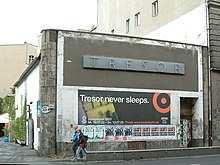Safe (club)
The Tresor in Berlin is one of the most famous techno clubs in the world. Since it opened in 1991, initially at Leipziger Strasse 126a in Berlin, and from 2007 in the disused southern wing of the Berlin-Mitte thermal power station , numerous DJs have played in the vault and some of them have started their careers here. With its events and the in-house record label Tresor Records , the club had an influence on the development of the techno scene in Germany and Europe .
history
At the beginning of 1991, Achim Kohlberger, one of the bosses of the West Berlin acidhouse club Ufo , discovered the vault of the former Wertheim department store built in 1926 together with an organizer of the Tekknozid parties while looking for a suitable location for a techno club to Leipziger Platz , located at Leipziger Straße 126. The Tresor Club opened three months later in March 1991 as the first techno club in Berlin. Its rustic, decoration-free furnishings in the former vaults in the basement of what was then the department store on Leipziger Strasse, which had been empty for decades in GDR times, with hundreds of broken lockers and the hard, machine music, were very well received in Berlin and throughout Germany. The safe gained international fame in a short time and became the epitome of a typical techno club.
During the Love Parade the event "Tresor-Park" took place with the Frankfurt DJ Sven Väth . In September 1991, the record label of the same name Tresor Records was launched by Dimitri Hegemann .
The most important resident DJs were Tanith , Jonzon , Rok , Roland 138 BPM , Terrible, DJ Clé , Mitja Prinz , Surgeon , Wolle XDP , Dash, Dry, DJ Crime, Wimpy, Zky and Djoker Daan. The safe became a platform for the international techno movement. DJs and live acts from Detroit such as Jeff Mills , Juan Atkins , Blake Baxter , Robert Hood , Kevin Saunderson , DJ Rolando and Kenny Larkin played particularly often in the vault. As a result , the typical safe sound with very strong influences of Detroit techno developed on the lower floor, the actual safe (also called the chamber ) . Other international acts also contributed to the defining sound. These included, in particular, Cristian Vogel , Joey Beltram , Neil Landstrumm and Dave Tarrida .
In the mid-1990s there were plans to build a Tresor West in Werl , which was prevented by local politicians due to citizen protests. These plans were then implemented in November 2019 at Dortmund's Phoenixplatz.
There were repeated rumors about the imminent closure of the Tresor Club. The area near Potsdamer Platz was cleared near the wall in GDR times, but became attractive again for development after the fall of the Wall. Right from the start, the club operators only got very short-term contracts. The last party in the old vault took place on April 16, 2005. The operator's initial idea of moving the entire vault to a different location and reopening it there was not realized. The vault and the rest of the Wertheim department store building were torn down at the end of May 2005. An office building was then built on the site.
From July 2005 onwards, safe parties took place under the motto “Tresor in Exile” in the Maria am Ostbahnhof premises or in SO36 .
On May 25, 2007, the club opened its new rooms in the disused southern wing of the Berlin-Mitte thermal power station on Köpenicker Strasse. Since then, events have been held on Mondays, Wednesdays, Thursdays, Fridays and Saturdays. Some of the original lockers from the old Wertheim department store were taken into the new rooms and installed in the lower event room, which is intended to preserve the memory of the old club. The film portrait of Joschka and Mr. Fischer was partly recorded on the premises.
Establishment of the club in Leipziger Strasse
The club had several rooms. On the first floor there was a large elongated floor called a globe . Mostly house-oriented music was played there. The light installation looked very warm and typical of a disco. On the ground floor there was also the Aurora Bar , a small room with its own bar, there were DJs there who filled the room and the toilets with sound. Art exhibitions took place on the ground floor, especially in the early days of the club.
The lower floor was reached from the globe via an old rustic staircase. Below was a flat vaulted cellar that contained a long, narrow room with a long counter. The old lockers of the Wertheim department store were still in the walls on both sides . From the stairs to the right, the vault ended in the actual vault, which was separated from the bar by a steel grille door. The style of music here was completely unique with very strong influences from Detroit techno . Gabber events were also often held there . The light installation here was minimal and gloomy: there were only stroboscopes and a blue light . A lot of fog was used for this.
Opposite the vault, the bar ended on another staircase that led outside. There was the Tuna Garden , a small garden with lots of plants, trees and seating. The area was illuminated and in summer offered space for a chill-out zone or another place for music from DJs or live acts. The Tuna Garden can also be reached from the ground floor. In winter the garden and the stairs were closed.
In the middle of 2001 the globe was enlarged and rebuilt. Video installations have also been added. Well-known decorations were u. a. the huge plasma lamp in the entrance of the globe, the old dungeon-like lattice doors and broken lockers downstairs in the vault as well as the wooden stage in the globe, on which either live acts played or danced.
media
In 2004, Mike Andrawis published the documentary "The Vault And The Electronic Frontier" about the history of the safe. The premiere took place on April 16, 2005 during the film festival Achtung Berlin! instead of.
The documentary Sub Berlin - Underground United was premiered in the Babylon cinema on April 17, 2009 as part of this film festival . The documentary won the award for Best Music Film at the Portobello Film Festival in London after its world premiere . The film by Tilmann Künzel tells both the story of the safe and the transition of techno from the underground to the public. Original recordings from the club as well as interviews with DJs, the team around Dimitri Hegemann and Patrick Reich, the managing director of the company that acquired the site for the construction of an office building, are shown. The documentary film and book of the same name by George Lindt tells the story of the safe and the life of the cultural manager and founder Dimitri Hegemann. The book accompanying the documentary contains previously unpublished photos from the time the club was founded and its various predecessors.
There are also many recorded videos and DJ sets in MP3 format on various video platforms and in forums on the Internet, including a report from a Japanese TV station about the closure in 2005.
In 2015, the Tresor was listed as one of three Berlin clubs in the global DJ Magazine Top 100 alongside Berghain and Watergate and landed at 87th place (2020: 53rd place).
Memberships
Tresor Berlin is a member of the Clubcommission Berlin eV
The club took part in the “ United We Stream ” campaign of the Berlin club scene, which suffered massive losses due to the measures taken against COVID-19 .
Web links
- Tresor Berlin website
- Sub Berlin: The Story of Tresor , documentation on YouTube
Individual evidence
- ^ Fritz H. Köser: Techno-Club Tresor: The steel door closes . In: spiegel.de , April 15, 2005
- ↑ https://www.djmag.de/einzelnews/tresorwest-berliner-techno-club-eroeffnet-ableger-in-dortmund/
- ^ Tresor Berlin: The Vault and the Electronic Frontier (2004) . In: movies.nytimes.com , accessed December 10, 2009
- ^ Tresor RIP - Balance of an attendant ( Memento of October 23, 2005 in the Internet Archive ) at 3headz.org, accessed on December 10, 2009
- ↑ Detlef Kuhlbrodt: So many stories . In: The daily newspaper: taz . April 15, 2005, ISSN 0931-9085 , p. 15 ( taz.de [accessed October 20, 2019]).
- ↑ Detlef Kuhlbrodt: So many stories , in: the daily newspaper from April 15, 2005. English synopsis on signandsight.com .
- ↑ Ji-Hun Kim: Sub Berlin - Underground United - Documentation about the former safe is running this weekend in Babylon Berlin . In: De: Bug of April 17, 2009. Retrieved April 19, 2009.
- ↑ portobellofilmfestival.com . Retrieved April 19, 2009
- ↑ http://djmag.com/top100clubs
- ↑ Top 100 Clubs 2020. Accessed April 2, 2020 .
- ↑ Safe - Club Commission Berlin. In: clubcommission.de. February 2, 2015, accessed July 1, 2020 .
- ↑ Home. Accessed April 14, 2020 (German).
Coordinates: 52 ° 30 ′ 36 ″ N , 13 ° 22 ′ 58 ″ E



